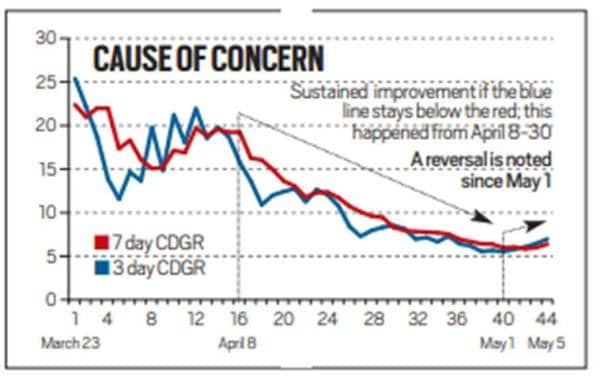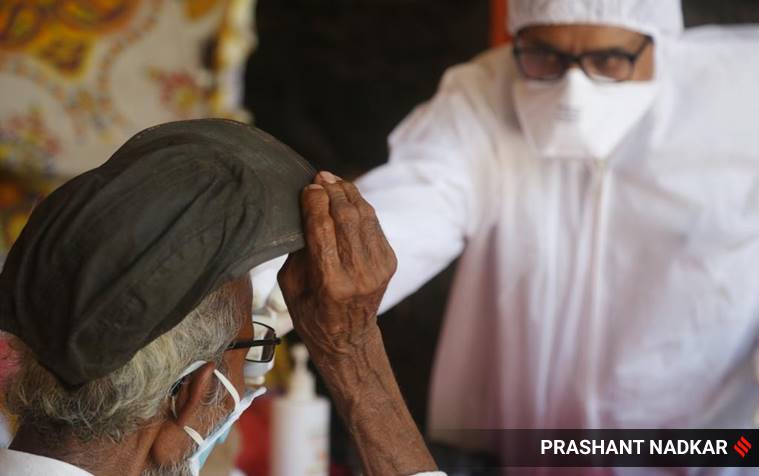According to figures shared by the Union Health ministry, the 7-day compounded daily growth rate (CDGR) of Covid-19 cases started dipping on April 8. The overall downward trend continued till May 1 when the curve started rising again. Since May 3, the 3-day CDGR curve has remained above the 7-day CDGR.

The CDGR factors in daily fluctuations and is more representative of the trend. To reflect a consistent improvement in checking the coronavirus spread, the more recent 3-day CDGR should stay below the 7-day CDGR, signifying an incremental reduction in the daily case rate.
As the graph shows, the 3-day CDGR mostly stayed below the 7-day CDGR as the latter nearly halved from 12.39 per cent on April 15 to 6.05 per cent on May 1. On May 4, however, the 3-day CDGR recorded its biggest edge – 0.45 per cent – over the 7-day CDGR since April 14. On Tuesday, May 5, this gap increased to 0.6 per cent.
 The doubling rate of COVID-19 cases slowed down from four days day in the first week of April to 11 days by the end of the month.
The doubling rate of COVID-19 cases slowed down from four days day in the first week of April to 11 days by the end of the month.
On Monday, Dr Randeep Guleria, Director, All India Institute of Medical Sciences (AIIMS), expressed concern over the fact that “the curve has not shown a downward trend”. A renowned pulmonologist, he is part of the core team of top officials reviewing and monitoring the pandemic in the country.
The doubling rate of COVID-19 cases slowed down from four days day in the first week of April to 11 days by the end of the month. While this indicates a gradual flattening of the case curve, the absolute numbers of daily new COVID-!9 cases are yet to show any dip.
It is important to note that the increase in the 3-day CDGR is not due to easing of the lockdown since May 3. The trend predates the beginning of the third phase of lockdown from May 4, and in any case, the impact of restrictions become evident only with a lag of at least a week. From the last few days of April, and certainly this month, the daily increase in numbers shows a divergence from the trend that had been holding till at least April 25.
Story continues below this ad
 Medical staff examines residents of Chunabhatti at a health camp at Sainath Seva Mandals hall, Mumbai.
Medical staff examines residents of Chunabhatti at a health camp at Sainath Seva Mandals hall, Mumbai.
The first four days of May saw the addition of more than 10,000 cases, which, in absolute terms, was more than what was added in the entire 21-day period of the first phase of the lockdown, though that phase had started with a much lower base.
As India increased the number of daily tests from under 5,000 since March to over 70,000 now, the case positivity rate – number positive cases per 100 samples – remained consistent in the 3-5 per cent range. On May 4, the daily case positivity rate of 4.23 per cent (2,572 cases from 60,783 samples tested) topped the cumulative rate of 3.87 per cent (42,835 cases from 1,007,233 samples tested) for the first time since April 26. Tuesday’s results confirm the early trend.
Also Read | Admissions under critical care see sharp fall under Ayushman Bharat
The 24-hour death count reported at 8 am on May 5 was 179, more than double the previous high of 83. The jump has pushed the overall case mortality rate — death per 100 cases — to 3.38 per cent, the highest since April 13 (3.46 per cent) when 51 deaths were recorded.

 Medical staff examine local residents of Chunabhatti, Mumbai for COVID-19 on Tuesday. (Express photo by Prashant Nadkar)
Medical staff examine local residents of Chunabhatti, Mumbai for COVID-19 on Tuesday. (Express photo by Prashant Nadkar)
 The doubling rate of COVID-19 cases slowed down from four days day in the first week of April to 11 days by the end of the month.
The doubling rate of COVID-19 cases slowed down from four days day in the first week of April to 11 days by the end of the month. Medical staff examines residents of Chunabhatti at a health camp at Sainath Seva Mandals hall,
Medical staff examines residents of Chunabhatti at a health camp at Sainath Seva Mandals hall, 





